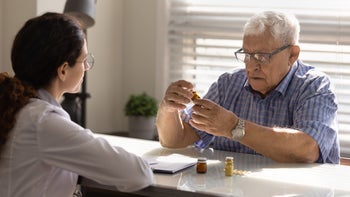
Heart Bypass Surgery: Recovery Time and Life Expectancy
Key takeaways:
Most people will make a full recovery after heart bypass surgery, and many can return to their normal activities in 6 weeks or less.
Serious problems are uncommon, but it’s important to notify your healthcare team if you have any concerns or unexpected symptoms.
Cardiac rehabilitation is an important part of the recovery process. It includes supervised exercise and education about nutrition and lifestyle.
Table of contents
Every year more than 300,000 people in the U.S. undergo coronary artery bypass graft (CABG) surgery. Also known as open heart bypass surgery, CABG (pronounced “cabbage”) is done to treat blocked heart arteries. It can prevent heart attacks, improve heart function, and greatly reduce symptoms like chest pain and shortness of breath. CABG can be lifesaving. The average life expectancy after CABG is about 18 years.
CABG is a major operation that can take between 3 to 6 hours to complete. And most people make a good recovery — serious complications after CABG surgery aren’t common. Heart surgeons go through years of specialized training. They work with teams of skilled nurses and other specialists to get their patients safely through surgery and back to a normal life.
That said, undergoing CABG can be overwhelming and scary. It may help to know what to expect after your procedure. Let’s take a closer look at recovery time, possible complications, and recommended lifestyle changes after bypass surgery.
Life expectancy after bypass surgery
Some people go on to live 20 years or more after CABG. And a very small number of people may die during or shortly after surgery.
There are a number of factors that help influence life expectancy after CABG. One study published in 2021 found that these factors were linked to lower life expectancy:
Female gender
Age over 70
Left ventricular dysfunction (unable to pump blood well)
Left main coronary artery involvement (artery supplying the left side of the heart)
Diagnosis of diabetes
Read more like this
Explore these related articles, suggested for readers like you.
Overall health status, including high blood pressure and high cholesterol, may contribute to lower rates of survival as well. Taking all risk factors into account, over 80% of people are still alive 5 years after CABG surgery.
Can you live a normal life after bypass surgery?
Many people who undergo bypass surgery have serious limitations to physical activity before the surgery. They may also experience mental health symptoms such as depression or anxiety due to their heart health. And a significant percentage of people who require a bypass report feeling some degree of social isolation due to their cardiac condition.
The good news is that bypass surgery has been shown to improve both physical and mental health aspects of people’s lives. Many people also report improved social interactions following bypass surgery. Most experts agree that CABG can significantly improve quality of life and help people live a more normal life.
How long does heart bypass surgery recovery usually take?
After CABG, most people stay in the hospital for 5 to 7 days. While you’re there, you can expect the following:
You will probably be on a ventilator, or breathing machine. In most cases, the ventilator can be removed after a few hours.
You will also have little patches with wires attached to your chest that allow your medical team to monitor your heart rate and rhythm.
You will have tubes coming out of your chest, which drain fluid and help your lungs recover.
You will have several other smaller tubes that go into your blood vessels. Medications are given through IV catheters. Others are used to monitor your blood pressure and heart function.
The surgeon has to cut through the breastbone, or sternum, to get to your heart. So, you will have a bandage or dressing down the center of your chest to keep that area clean and protected.
Over the next few days, as you recover, those tubes will gradually be removed. And even while you have those tubes in place, your care team, including nurses and therapists, will get you out of bed as soon as it is safe. Moving around helps your breathing, blood flow, and strength. Although this sounds uncomfortable, medication will help ease the process.
When you leave the hospital, you will likely go home. But if you are very weak or need extra help, you may go to a rehabilitation hospital for a few weeks. There, you can rebuild your strength and make sure you’re ready to resume daily activities.
If you have a desk job, you may be able to return to work in 6 weeks or less. If your job is more physical, it could be several months before you are cleared to return.
Complete healing usually takes more than 3 months. Your cardiac rehabilitation team will give you guidance through the stages of your recovery (more on this below).
What should you avoid doing after having CABG surgery?
Your body needs quite a bit of time to heal after a major surgery like CABG. It’s important to follow your care team’s instructions and ask them when you have questions. They will likely advise you to avoid certain activities while you recover, some of which may include the following:
Don’t move anything heavy. It takes time for the sternum to heal. So, for at least a couple of weeks after surgery, most people should avoid lifting, pushing, or pulling more than 10 pounds.
Don’t overuse your arms. You should also limit use of your arms to simple, everyday tasks like getting dressed and playing cards. In other words, don’t lift your arms above your head or behind your back.
Don’t drive for the first 2 to 3 weeks. This helps avoid injuring your chest, but it’s also because you may still be on pain medications and not feeling 100% yet.
What are the most common complications during CABG open heart surgery recovery?
When you are ready to go home, you will be given a list of medications and instructions to help you recover from your operation. You will likely have some new prescriptions, and you may be told to not take some of your old medications. This may seem a little overwhelming at first, but your nurse will sit down with you and go over the instructions in detail. If you have any questions, your nurse will be able to help make things clear before you leave.
Infection
Infections of the surgical incisions can sometimes happen after surgery. The best way to avoid this is to keep your wounds clean and dry. It’s usually OK to shower, but you will probably be told not to soak in the tub for at least a month.
Also, be sure to change your incision dressings according to your discharge instructions. If you notice redness or swelling at the incision, or any pus or drainage from it, contact your surgeon right away. This could be a sign of infection.
Infections of the breastbone are uncommon after open heart surgery, but they can happen. People who smoke or who have diabetes are at higher risk for infections of the bone as both factors can affect healing. Be sure to notify your surgeon if you have fever, chills, or wound pain that gets worse so they can help prevent serious complications.
Depression
Going through CABG is scary. Even though the goal is to get you back on your feet, in the days and weeks after surgery you may feel like you have lost control of your life and your health. It’s no wonder that depression after CABG is very common. In fact, as many as 1 in 4 people experience symptoms of depression in the weeks or months after surgery. Your primary provider can usually help you get through this, so don’t hesitate to reach out if you need help.
Heart-related problems
After open heart surgery, you may have other heart-related complications. Other issues to look out for include:
Irregular heartbeat
Shortness of breath
Weight gain of more than 5 pounds
Swelling in the legs
High or low blood pressure
If you experience any of these problems, or other concerns, reach out to your surgeon or cardiologist. These symptoms could be a sign that:
You are having problems with your heart rhythm or heart strength
You may be retaining fluid
Your medications need to be adjusted
Whatever the cause, it’s best to get help early to get you back on track to better health.
What is the fastest way to recover from bypass surgery?
The fastest way to recover is to be patient with yourself. Take time to return to a normal routine — don’t try to rush it. Know that your cardiac care team wants you to recover and is available to help you through this process.
Perhaps one of the most important steps to recovery is your outpatient cardiac rehabilitation program. This usually starts a few weeks after surgery. It includes guidance on exercise, nutrition, and lifestyle — all the keys to heart health after CABG. The program is supervised by therapists who are specially trained to care for people with heart conditions.
In general, cardiac rehab programs last at least 6 weeks. But the length can vary depending on your needs. It’s common to think it’s unnecessary or even too time consuming. But it can’t be stressed enough how important it is. Please speak with your care team if you have financial or other concerns.
Do you have to make any dietary changes after heart bypass surgery?
A heart-smart diet is always a good choice, whether you have had surgery or are simply trying to stay healthy and strong. The Mediterranean diet is a great option. This eating plan is rich in:
Fruits
Vegetables
Whole grains (quinoa, oats)
Nuts
Olive oil
Dairy products
Fish
Poultry (chicken, turkey)
This easy-to-follow diet has been proven to reduce heart-attack risk and improve the health of the arteries. For some people, cutting back on salt is also important, since salt may contribute to high blood pressure and fluid buildup.
Foods to avoid after coronary bypass surgery
The reason most people need open heart surgery is because they have one or more blocked coronary arteries. And diet is a major factor contributing to blocked arteries.
After surgery, it’s more important than ever to avoid the foods that are thought to cause coronary artery disease. Some of the foods to strictly limit or avoid include:
Sweetened beverages (soda, fruit drinks, and fancy coffee drinks)
Salty snacks (like processed nuts, chips, and pretzels)
Sweet treats (like candy, ice cream, and chocolate)
Fast foods (like pizza, burgers, fries, chicken nuggets, and fish sticks)
Processed meats (like bacon and sausage)
Baked goods (like pastries, cookies, and cakes)
Foods high in saturated or trans fats (butter, lard, and red meat)
Foods with added sugar
Foods with added salt
Alcohol
The bottom line
Heart bypass surgery can save your life, improve your well-being, and help you get back on track to a healthier life. Complications are uncommon, but you can help avoid them by following your healthcare team’s recommendations. Don’t hesitate to notify your surgeon or cardiologist if something doesn’t seem right. And don’t forget about cardiac rehabilitation. It will help to speed up your recovery and give you tools to stay healthy for the years ahead.
Why trust our experts?



References
American Heart Association. (2020). Post surgery milestones: Managing your mood, expectations and goals.
American Heart Association. (2020). What is the Mediterranean diet?
Cahalin, L. P., et al. (2011). Sternal precautions: Is it time for change? Precautions versus restrictions — A review of literature and recommendations for revision. Cardiopulmonary Physical Therapy Journal.
Dontas, A. S., et al. (2007). Mediterranean diet and prevention of coronary heart disease in the elderly. Clinical Interventions in Aging.
iData Research. (2018). New study shows approximately 340,000 CABG procedures per year in the United States.
Jimenez-Torres, J., et al. (2021). Mediterranean diet reduces atherosclerosis progression in coronary heart disease: An analysis of the CORDIOPREV randomized controlled trial. Stroke.
Lenz, K., et al. (2016). Coronary artery bypass surgery in diabetic patients — Risk factors for sternal wound infections. GMS Interdisciplinary Plastic and Reconstructive Surgery DGPW.
Milojevic, M., et al. (2019). Life-long clinical outcome after the first myocardial revascularization procedures: 40-year follow-up after coronary artery bypass grafting and percutaneous coronary intervention in Rotterdam. Interactive Cardiovascular and Thoracic Surgery.
Mosorin, M. A., et al. (2015). Five-year outcome after coronary artery bypass surgery in survivors of out-of-hospital cardiac arrest. Frontiers in Surgery.
National Cancer Institute. (n.d.). Peripheral venous catheter.
National Health Service. (2021). Living with coronary artery bypass graft.
National Heart, Lung, and Blood Institute. (2022). What is a ventilator?
National Heart, Lung, and Blood Institute. (2022). What to expect during surgery.
Origuchi, H., et al. (2020). Active participation in outpatient cardiac rehabilitation is associated with better prognosis after coronary artery bypass graft surgery — J-REHAB CABG study. Circulation Journal.
Schmidt-RioValle, J., et al. (2020). Quality of life after coronary artery bypass surgery: A systematic review and meta-analysis. International Journal of Environmental Research and Public Health.
SecondsCount. (2023). Coronary artery bypass graft surgery.
Sharif-Kashani, B., et al. (2016). Smoking and wound complications after coronary artery bypass grafting. Journal of Surgical Research.
Shin, Y. C., et al. (2015). Sternal healing after coronary artery bypass grafting using bilateral internal thoracic arteries: Assessment by computed tomography scan. The Korean Journal of Thoracic and Cardiovascular Surgery.
Soltani, M. H., et al. (2021). Short and long-term outcomes of patients with coronary artery bypass surgery. ARYA Atherosclerosis.
Weintraub, W. S. (2003). Twenty-year survival after coronary artery surgery. Circulation.




























